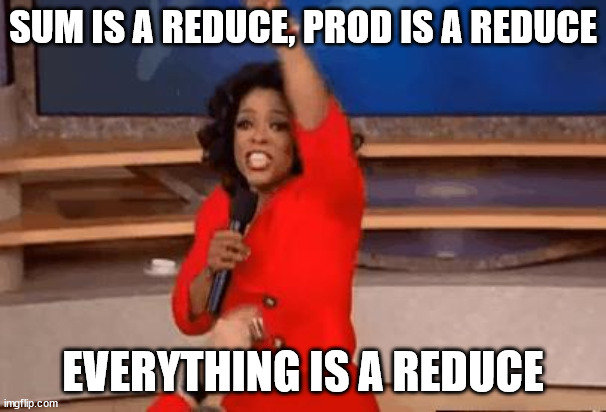This is the written version of a lightning talk I gave at EuroPython 2022 in Dublin. If you prefer, you can watch the recording of my presentation:
Here is the written version of this talk:
Quiz time
Can you please tell me the result of the expression that follows?
>>> 1 + 2 + 3 + 4You probably got it correct, it's 10:
>>> 1 + 2 + 3 + 4
10Now, what about this next expression?
>>> 1 * 2 * 3 * 4You probably got this one correct as well, it's 24:
>>> 1 * 2 * 3 * 4
24What about this one, instead:
>>> True and True and False and TrueThis Boolean condition evaluates to False, which you probably also knew.
>>> True and True and False and True
FalseIt is very likely that you understand all these three expressions. After all, they are fairly simple. Now, the question is... What's the pattern here?
Pattern?
Take a look at the three expressions:
>>> 1 + 2 + 3 + 4
10
>>> 1 * 2 * 3 * 4
24
>>> True and True and False and True
FalseWhat is the pattern that they exhibit? These three expressions are structurally similar... But in what way?
Binary function
Well, the three expressions make use of a binary function.
That's +, *, and and, in the three expressions.
“Binary” here means they accept two arguments,
which is true of +, *, and and:
# +
>>> 1 + 2 + 3 + 4
10
# *
>>> 1 * 2 * 3 * 4
24
# and
>>> True and True and False and True
FalseList of values
Another commonality between the three expressions is that we are working with “a bunch of values”, which I can represent as a list of values:
# +, [1, 2, 3, 4]
>>> 1 + 2 + 3 + 4
10
# *, [1, 2, 3, 4]
>>> 1 * 2 * 3 * 4
24
# and, [True, True, False, True]
>>> True and True and False and True
FalseSingle result
Finally, when we take the binary function we are working with and use it to smoosh all of the values in the list of values, we get a single result. In all three cases:
- smooshing
[1, 2, 3, 4]with addition+gives10; - smooshing
[1, 2, 3, 4]with multiplication*gives24; and - smooshing
[True, True, False, True]with the logicalandgivesFalse.
# +, [1, 2, 3, 4], 10
>>> 1 + 2 + 3 + 4
10
# *, [1, 2, 3, 4], 24
>>> 1 * 2 * 3 * 4
24
# and, [True, True, False, True], False
>>> True and True and False and True
FalseIn short, these three expressions could be summarised by:
- the binary function that I was using;
- the values that were smooshed together by that binary function; and
- the result we obtain.
This pattern is useful!
So, I gave you three expressions following a specific pattern. But is this pattern useful?
It is a useful pattern! In fact, these three examples correspond to three well-known functions in Python:
10 == sum([1, 2, 3, 4])
24 == math.prod([1, 2, 3, 4])
False == all([True, True, False, True])This pattern is a reduce!
This pattern is very useful and it even has a name.
The module functools contains a tool, reduce, that we can use to express this pattern.
In other words, we can implement all of the three functions mentioned above in terms of reduce!
Why is that?
Because reduce needs a binary function and a list of values,
and will then proceed to smooshing all of the values,
with the given function, to produce a single result:
reduce(+, [...]) == sum
reduce(*, [...]) == math.prod
reduce(and, [...]) == allEverything is a reduce!
Not only are sum, math.prod, and all, specific cases of reduce,
but there are many other built-ins that are reductions or very similar to reductions.

Some other examples include the built-ins any, max, min, and str.join.
What gives?
But hey, what gives?
Why do I care about reduce?
I am of the opinion that understanding that all of these built-ins are related gives you a deeper understanding of the functions themselves.
In turn, understanding these functions makes it simpler for you to understand the general form of reduce,
which also means you gain one more tool for your tool belt.
After all, as programmers, that is one of the things we are most interested in:
knowing about the tools at our disposal, so that we can use the right tool for the job, always.
Finally, there is also a more philosophical advantage to it, in that when you deepen your knowledge of how all these things work, and when you realise there are connections between different things that seemed disconnected, you start building a more complete picture of how things are the way they are and you improve your knowledge of algorithms and programming, in general.
And, to me, few things are more elegant than expanding my knowledge and filling in all the gaps that I can.
Prolog
If you would like to learn more about functools.reduce,
I have written a Pydon't about the power of reductions.
Become a better Python 🐍 developer, drop by drop 💧
Get a daily drop of Python knowledge. A short, effective tip to start writing better Python code: more idiomatic, more effective, more efficient, with fewer bugs. Subscribe here.
